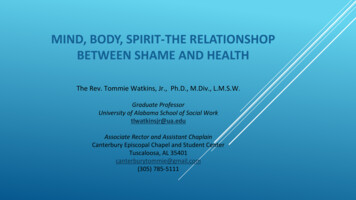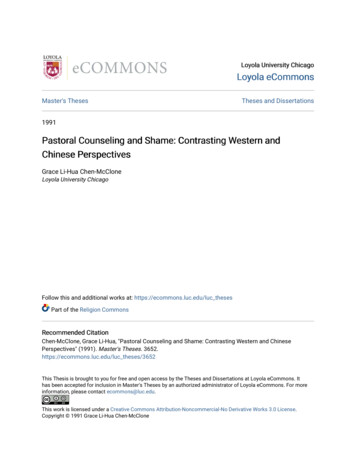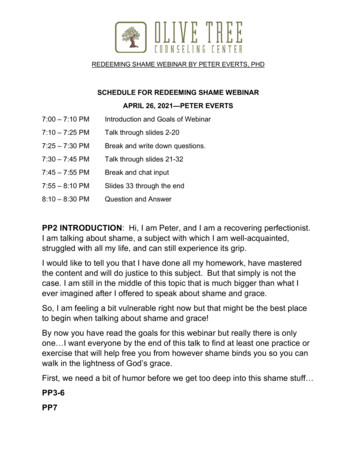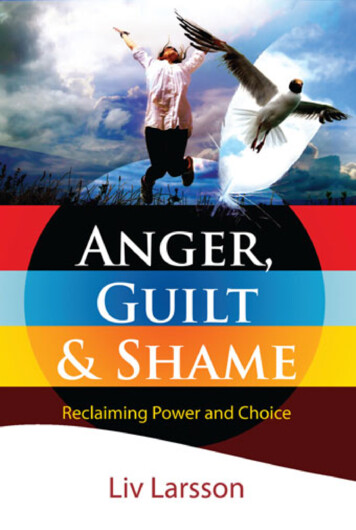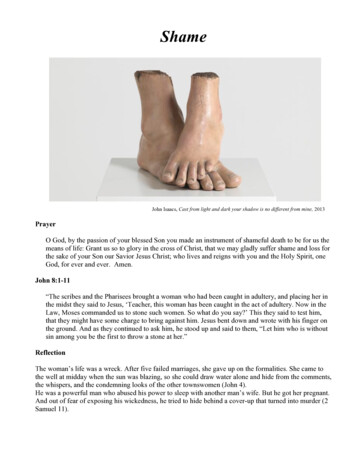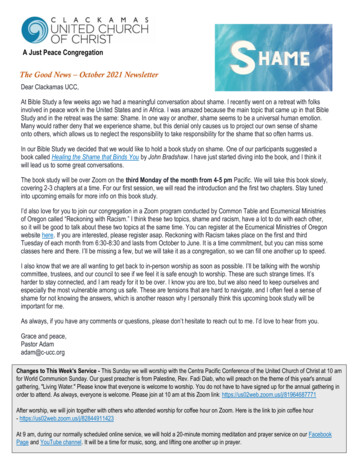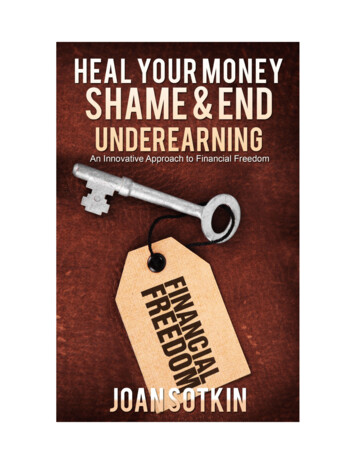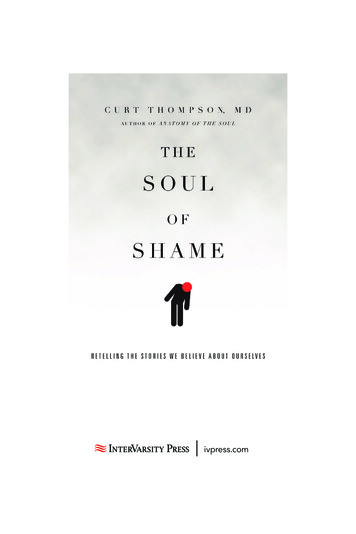
Transcription
Understanding and Addressing Internalized ShameBy Donna Wasson, MA, LCPCWe’ve all heard that Taiwan is a “shame-based” culture, but what is shame, how is it transmittedand what are its effects? Internalized shame is a common theme in many people’s lives. It is oftenseen in survivors of childhood abuse, domestic violence and sexual assault. Dysfunctional homes(and who really comes from a “functional” home?) often produce shame in their members. Parentswith internalized shame pass it on to their children. Many missionaries struggle with the feelings,and the Taiwanese have woven it into their society.John Bradshaw in his book, Healing the Shame that Binds You, says “Toxic Shame, the shame thatbinds you, is experienced as the all-pervasive sense that I am flawed and defective as a humanbeing. Toxic shame is no longer an emotion that signals our limits, it is a state of being, a coreidentity. Toxic shame gives you a sense of worthlessness, a sense of failing and falling short as ahuman being. Toxic shame is a rupture of self with the self.” (page 10.) While guilt might tell awoman, “You made a mistake,” toxic shame will tell her, “You are a mistake. You are worthless,hopeless, and bad.”Is there healthy shame? Healthy shame recognizes that you can make mistakes and have limits. If Ibragged to everyone that I was going to win the Iron Man Marathon Race during TMF conferencebut then lost (inevitable for me!), I would rightly feel a sense of shame. I thought I was better thanothers and forgot my own limitations. That sense of shame can be remedied and brings humility. Ican laugh at myself for such a lapse in judgment and apologize to those I had offended. Healthyshame reminds me of real boundaries and teaches me to be humble.How does toxic shame begin? In many cases, children may experience shame for having certainfeelings, needs or drives. When an area is consistently identified by the “shamer” (a parent, teacher,authority figure, peer) as bad, a child eventually cuts off and does not allow himself to have thoseparticular feelings, needs or drives. As he grows up and as an adult, those same feelings, needs anddrives produce deep emotions of shame and worthlessness. This would be evidence of internalizedshame. As many do, he might try to cover his inner bad “self” and outwardly present an idealized“false self” that is extremely good. If he didn’t, the world would find out how bad he really is.“Feelings” can include excitement, enjoyment, surprise, anger, fear, distress, shame, disgust, etc.“Needs” that are shamed frequently include the need for friendship, touching/holding,identification, differentiation, nurturing, affirmation, power, etc. “Drives” usually refers tosexuality, hunger, and anything relating to goals and purpose. All are legitimate and normal, butobviously they must all be managed, disciplined, and developed appropriately.There are certain behaviors that “shamers” commonly use that instill unhealthy shame and fear.Little boys and girls usually believe only a terrible child would elicit such behaviors and facialexpressions in someone they love. They typically see themselves “mirrored” in the faces of parents(and others) and do not like what they see. Typical behaviors associated with a “shamer” include: Voice is loud, fluent, abrasive Person may point or shake forefinger Staring, glaring eye contact Sharply cutting off eye contact with shamed person1
Erect posture Facial look of disgust or dissmell (like smelling something rotten) Aggressive physical approach that violates territorial boundary of the shamed person Mocking imitation of the shamed person’s behavior or words Derisive, sharp laughter Use of words that belittle the person shamed Physically assaulting the shamed person Ostracizing the shamed person in front of a group of people Stand “towering above” the shamed personTypical behaviors associated with being shamed include: Eyes down (sustained eye contact is intolerable) Head hung Shoulders slumped Face, cheeks flushed Paralysis of movement (“frozen in one’s tracks”) Interrupted spontaneity of movement Voice stammers, softens, and/or stops Extremities become cold (state of physiological shock) Changes in galvanic skin response (hands start to sweat) Attempts to hide or withdraw Fidgeting or squirming CryingWhen leading a recovery group for survivors of childhood sexual abuse, I found these lists elicitedstrong emotional reactions in group members. They tearfully described childhood experiences ofbeing shamed. It was freeing for them to realize that anyone would have felt shamed in thoseexperiences, and they were not abnormal.Stages of ShameShame can be seen in three stages, progressively becoming more generalized and pervasive. StageOne consists of Basic Shame Binds where shame is specifically focused on a particular feeling,need, or drive. The “bind” comes as a child (or adult) has a normal feeling, need or drive, but ismade to feel he should not. For example, Johnny falls down and cuts his knee and begins to cry;his father screams at him, “Only babies cry.boys do not cry.stop crying.” Johnny’s legitimate2
pain and sadness has been invalidated, causing him to feel ashamed for crying. If this scene isrepeated often enough, he learns not to cry. He might also learn to ignore his feelings anytime hefeels pain and sadness. As an adult, he may feel stupid and worthless (in other words, shame)whenever he feels distressed, telling himself, “I shouldn’t feel like this.” Sometimes, instead offeeling depressed when faced with a legitimately sad situation, he may feel nothing at all. I haveheard many Chinese people report an absence of emotions, rather than a clear sense of shame andworthlessness.In Stage Two, shame is generalized to: A) Body shame—feeling ashamed about everything havingto do with the body. B) Relationship shame—feeling bad about their relationships in a myriad ofways and scared of intimacy. C) Competence shame—feeling that you cannot do anything wellenough, and if you do, you should apologize (or do it better). MeiLi may have been consistentlycriticized and humiliated for missing points on her homework and exams, even though she wasusually at the top of the class. First by her parents and then teachers, she repeatedly saw looks ofdisgust and repulsion when she didn’t get first place or 100%. She tearfully remembers her motherripping up some exam results in front of her siblings because her scores weren’t as high as hercousin’s, asking, “Are you my daughter? How could I have such a stupid child?” Now at age 35,people see her as successful but can’t understand her strange lack of self-confidence andmotivation. When praised, she feels deeply ashamed of her inadequacy.In Stage Three, Character Shame becomes the core of the person’s identity; there is nothing “right”about them. Many counselees with this kind of shame describe a kind of blackness or void at thecenter of their being, which they are very afraid people might see. If people get too close, theymight see and understand and run as fast as they can! OR.if friends get too close, they might getinfected and their lives could be ruined as a result. Such is the power of internalized shame. Mostwould not identify shame as an emotion; for them it is just a fact of existence!Mary is a deaconess in the church and busy about the work of the Lord. Many see her as theepitome of sacrifice and service, selflessness and faithful giving. The pastor and others feelfrustrated in their attempts to know her, because the conversion always gets deflected to somethingelse. If the truth were known, Mary is depressed most of the time but works hard not to show it.She knows she never does enough and doesn’t really “rate” as a deaconess—that was a fluke in thevoting last year. She hates her body, and thinks about it as little as possible, rarely looking in amirror. She wants intimacy but can’t seem to bridge that gap. She feels tired, hollow, incomplete.Controlling and Releasing ShameIn whatever stage a person might be, he will attempt to control that sense of shame. If I feel badabout myself, I might try to show myself that I am actually okay. And I may want to prove toothers that I am an okay person, too. Many people fall into the trap of perfectionism, superachievement, winning, care taking, rescuing, and people-pleasing in order to control their sense ofshame and prove to themselves (and others) that they are really good. Some dare not talk lest theysay something wrong. Unfortunately, others become overly critical, blaming, contemptuous andpatronizing in an attempt to feel superior.and others feel inferior.Additional strategies to control shame may include compulsive behaviors that can drive and enslavethe individual. Such compulsive behaviors may include dieting/fasting, “workaholism”, cleaning,washing, mental detailing, undoing, hording/saving, and being over-scrupulous or puritanical.Whatever method the person uses to control their sense of shame, there is increasing pressure andstress to live up to the highest possible standard. No one can live with that kind of stresscontinually and so there must be a break--some way to let go, even if that release is temporary andcauses more problems. Some people lose their tempers, have dramatic emotional outbursts, become3
unpredictable, or indulge addictive behaviors. Addictions can include alcohol and other drugs,food, sex, video games, spending, excitement, high emotionality, physical abuse, sexual abuse,verbal abuse, and self-injury. All are ways to release tension.Some busy people suddenly give up, walk away, become ill, or just get depressed, as a way toescape the high stress of shame-based achievement. Regardless of the manifestation of shame, theperson becomes increasingly self-oriented and self-indulgent, even though there are manyseemingly altruistic behaviors. Such “releasing behaviors” cause the person to feel ashamed andembarrassed. Once again, he (or she) is driven to control the sense of shame and feel better. It is apainful and oppressive cycle. Is there anyway out?Ways of Escape—bringing it into the LightEmbracing this shame is painful, but “the only way out is through,” says Bradshaw. (pages 115116). What is internalized must be “externalized” in order to be healed. That which is hidden mustbe brought out in the light. As Christians, we are in a unique position to address these hidden andinternalized wounds of shame. Conceptualizing broadly in terms of grace, love and renewal, thefollowing are some of my preliminary thoughts about the healing of shame.Give people grace, unmerited favor and acceptance! Shame prevents people from acceptingthemselves or believing that others can love them. People with high shame levels are not alwaysthe easiest people to love, because they put up barriers and defenses. These folks need to extendthemselves grace, but may only be able to understand that as they experience grace from lovingpeople. This is what the Church does best—reaching out to people where they are and giving thema place to belong. (Small groups are great for this.) Hopefully, grace is what Christians can offer,because of the unconditional love and acceptance we have experienced personally through Jesus.God wants to extend grace to these friends through His people! Some of my clients expect me toscold them, or worse, to laugh at them! They are deeply affected by the acceptance and concernoffered them, which begins the healing process.Give people your love! This is what people with great wells of internalized shame have neverreally had. Unconditional love—unearned, no strings attached, never ending. God offers this to usfreely.and with His power and grace, we can offer it to others. Obviously love is not easy and whois equal to the task? It takes prayer, commitment, courage and time. The church of Christ is againuniquely positioned to offer God’s unconditional love through its fellowship of believers. Onebeliever alone cannot do this work, but a body of believers can provide a loving, safe, and balancedenvironment to embrace those who are hurting. Of course, the church is not perfect, and there arethose who will site the church as one source of their suffering. We need to go forward humbly,acknowledging our failures, keeping our eyes on Jesus. We love because God first loved us.Nurture renewal when the time is right! “Be transformed by the renewing of your mind.” (Romans12:2) Grace and love come first because they provide the safety needed to continue along this path.Renewal then involves being honest with ourselves, God, and others. Instead of avoiding andhiding the pain, it needs to be felt, talked about, understood, and shared with safe people who canaccept us. Looking at the hurts and shame is necessary in order to legitimize the suffering of thepast, normalize it, and give proper prospective. This feels very scary for people with a lot ofinternalized shame. When grace and love provide safety, processing can be done slowly with theright people. Professional counselors might be appropriate, but they cannot be the only ones. Thechurch again is uniquely qualified to provide a healing environment. As missionaries, can we lookat our own shame issues as well as assisting those around us?Renewal means flawed assumptions and bitter attitudes need to be examined. It points to rejectingor changing those old messages, as well as accepting new truths about who we are. We are okay,4
we are acceptable, we have okay emotions, it’s all right to make mistakes, we are beloved childrenof God, and we can have good things, too. Renewal suggests making better decisions about what Ido with my time, which people I trust, and the priorities I set. Discipleship, mentoring andaccountability can provide needed scaffolding as renewal and rebuilding takes place. For those ofus in ministry, we need to teach our people to renew their self-image by knowing who they are inChrist and the new identity they have in Him.Continue in prayer! My experience has shown that some people with deep cores of internalizedshame find it hard to pray, even among Christians. Issues, such as authority, anger, fear,inadequacy, father figures, and injustice (“where was God when this happened?”), can complicatethe healing process by hindering prayer. Be prepared. It may be that prayer by others will be thefirst step, starting alone and later with the person present. If Mary cannot pray to God about herfeelings, then I can pray for her, as well as gently following the Spirit’s leading in how to workthrough these issues. Later she can be encouraged to pray herself, perhaps writing her prayers ifthat is helpful. The real work of lasting renewal can only come through God, and we want to leadthem to this place at the right pace.Many scholars are researching the effects of shame and writing books. However, healing is anintensely personal experience for those recovering from its grip, and they cannot do it alone. Canwe minister to each other? Can we reach out to the Taiwanese around us? May He give us theheart and capacity to extend His grace, love and renewal to those hurting with issues of internalizedshame.Quotes from: Bradshaw, John. Healing the Shame that Binds You. Deerfield Beach, FL: HealthCommunications, Inc., 1988.What If You Have Shamed Someone? Counsel For the Other Half.Do you see yourself in this article as someone who has been the offender? If totally honest, weprobably can all think of times when we have hurt someone by our words and actions. Perhaps wesee the serious consequences of using shame to discipline our children or to get people to respondthe way we want them to. What do we do how do we make it better? Pray and seek God’s guidance and forgiveness. Bring your confessions to an appropriatethird party, such as a pastor or mature Christian. Apologize if you can do so without causing further harm. Be specific--what you did, whyyou did it, why it was wrong. How this is done should be based on what’s in their bestinterest. Be prepared to listen and acknowledge their pain. Be honest about yourmistakes and the reasons that drove you as this can facilitate healing and free them fromself-blame. Don’t expect forgiveness or reconciliation, or any other response. You canhope and pray for this, but it is for them to decide. Restitution. Can anything be done to make amends? Should you pay for counseling?Replace something you took away? Are you still prone to shaming behaviors? Anger and bitterness may be signals thatsomething is wrong. Most “shamers” carry their own heavy burden of internalizedshame. Get help now. Find a Christian counselor, a capable pastor, or mature friend whocan assist you in getting to the root of these problems.5
Counseling and Other Resources – Bibliographysupplied by Donna WassonAinscough, Carolyn, and Toon, Kay. Surviving Childhood Sexual Abuse, a Practical SelfHelp for Adults Who Were Sexually Abused as Children. New York: Fisher Books, 2000.Allender, Dan B. The Wounded Heart, Hope for Adult Victims of Childhood Abuse.Navpress Publishers, 1990.---christian perspective for abuse survivors.Balswick, Jack 0., Blaswick, Judith K. The Family: A Christian Perspective on theContemporary Home. Grand Rapids, Michigan: Baker Book House, 1991.Bass, Ellen and Davis, Laura. The Courage to Heal, A Guide for Women Survivors of ChildSexual Abuse. New York: HarperPerennial, 1998.--a classic book for survivors listing issues and suggestions for recovery. It can be quiteheavy for a survivor, so encourage her to read only what she can handle. The book has receivedcriticism about its stance on repressed memories, but is otherwise a helpful book.治療的勇氣 作者: 愛倫貝絲 (Ellen Bass) 與 蘿拉戴維絲 (Laura Davis) 出版: 生命潛能Beattie, Melody.Codependent No More. New York: MJF Books, 1987.Beyond Codependency. New York: MJF Books, 1989.---classic books on codependency, a common problem for many survivors.超然獨立的愛 – 擺脫不健康的共依存 Melody Beattie 著吳幸宜 譯 出版社: 遠流出版公司(大眾心理學 164)Bradshaw, John. Healing the Shame that Binds You. Deerfield Beach, FL: Hea1thCommunications, Doc., 1988.---not a Christian book, but an excellent work on the origin, results, and recovery frominternalized shameCloud, Henry, and Townsend, John. Boundaries. When to Say Yes, When to Say No toTake Control of Your Life. Zondervan, 1992.Also good:Boundaries with KidsBoundaries in MarriageBoundaries in DatingChanges That Heal---classic works on how Christian can maintain their own boundaries; there are alsoworkbooks in English for each of these books.Gil, Eliana. Treatment of Adult Survivors of Childhood Abuse. Walnut Creek, CA: LaunchPress, 1988.---a book for counselors by top therapist in this fieldHeitritter, Lynn, and Vought, Jeanette. Helping Victims of Sexual Abuse, A Sensitive,Biblical Guide for Counselors, Victims and Families. Minneapolis, MN: Bethany House Publishers,1989.Herman, Judith. Trauma and Recovery: The aftermath of violence-from Domestic Abuse toPolitical Terror. New York: BasicBooks, 1992.--- a heavier book for counselors and leaders; a classic read6
Kennerley, Helen. Overcoming Childhood Trauma,A Self-Help Guide Using CognitiveBehavioral Techniques. New York: New York University Press, 2000.--- a step-by-step recovery plan to process memories and get control backLin, Phylis Lan; Mei, Ko-wang; Peng Huai-chen; editors. Marriage and the Family inChinese Societies. Selected Readings. Indianapolis, Indiana: University of Indianapolis Press, 1994.---although dated, it has some interesting articles and research from both Taiwan and theMainland.Maltz, Wendy. The Sexual Healing Journey. New York: HarperCollins, 1991.---Many survivors have differing problems with sexual intimacy. This book for survivorsprovides insight and suggestions.McGee, Robert S. Father Hunger Ann Arbor, Michigan: Servant Publications, 1993.Norwood, Robin. Women Who Love Too Much. New York: Pocket Books, 1985.---gives insight into why women persist in destructive relationships/marriages愛的太多的女人 (l'm not sure of the publisher, but l'm told the translation does notflow like the English.)Payne, Leanne.The Healing Presence. Grand Rapids, Ml: Baker Books, 1989Restoring the Christian Soul. Grand Rapids, Ml: Baker Books, 1991.---classics for inner healing.Seamands, David A.Healing for Damaged Emotions. Chariot Victor Publishing, 1981, Also authored:Healing Grace: Finding a Freedom from the Performance Trap (1999),Redeeming the Past. Recovering from the Memories that Cause Our Pain (1987)Putting Away Childish Things. Reaching for Spiritual and Emotional Maturity inChrist (1999)Healing Your Heart of Painful Emotions (1993)Walker, Lenore. The Abused Woman. A Survivor Therapy Approach. New York: NewbridgeCommunications, Doc., 1994.---a clinical video and manual about treating battered women.VanVonderen, Jeff. Tired of Trying to Measure Up. Minneapolis, MN: Bethany HousePublishers, 1989.---good book for any Christian who struggles with trying to be good enough and the shamethat results from failure7
In Stage Two, shame is generalized to: A) Body shame—feeling ashamed about everything having to do with the body. B) Relationship shame—feeling bad about their relationships in a myriad of ways and scared of intimacy. C) Competence shame—feeling that you cannot do anything well enough, and if you do, you should apologize (or do it better).



